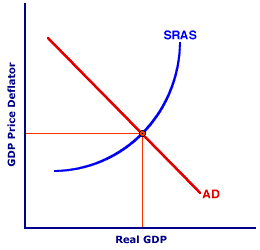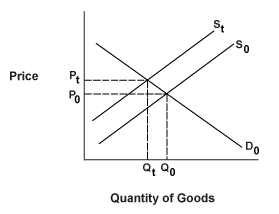There are three different approaches which we can use to determine the national income. We're going to review all of them in a big, boring, and utterly painful lecture.
1) GDP from Value Added Approach- a measure of the value of all goods and services produced in a fiscal year
2) GDP from Expenditures Side- a measurement of the flow of expenditure
3) GDP from Income Side- a measurement of the flow of income
THE VALUE ADDED APPROACH
Problem: Why not just add the value of each producer's individual output?
Answer: Because production occurs in stages, so in order to avoid counting inputs twice (ie: counting the steel used to build a car, and then the car as well), we must either include only final products in our math, OR only count the value added to products at each stage of production.
Definitions:
Double Counting: Adding the value added more than once to the final value of a good or service
Intermediate Good: output which is used as an input for another good (ie: steel used to build a car)
Final Good: Output NOT used again as an input- output used for final consumption in the time period being considered
Value Added: The value which is added to a product at each stage of production. Revenue minus the cost of intermediate goods from other firms (ie: if a car sells for $2000, and the parts used to make it cost $1000, the added value is $1000). Value added is equal to factor income (WRiP) for any stage of production.
Revenue: Factor Income (WRiP) + The cost of intermediate goods from other firms.
NOTE: Value added does not factor in the costs of factors of production from other firms (so it does not matter how much it costs a steel manufacturer to produce car-steel: this is not factored into the final value of the car)
SO...
GDP (A measure of national income) is the FINAL (not intermediate) MARKET VALUE (determined by the price system of supply and demand) of all GOODS AND SERVICES (goods are tangible, like watermelons. Services are intangible, like haircuts) PRODUCED (so only actual output is measured- flipped assets like stocks or resold real estate does not factor into GDP) in a GIVEN PERIOD (A fiscal year is April to April)
THE EXPENDITURE SIDE APPROACH:
GDP is also equal to the total amount of expenditure required to produce all of the outputs which GDP encompasses.
There are 4 different players in the economy, and thus there are 4 different types of expenditure
CONSUMPTION- Expenditure by the household. This is the 'using up' of a product by a final user. Expenditure can be on durable and non durable goods, as well as services
INVESTMENT- Expenditure by the firm. Investment refers to a change in Capital (Plant, Equipment, Inventory, or Residential Construct). Most of the time, investiture is on goods which are NOT intended for present or immediate consumption. Also, investment is for goods which are used to produce other goods (ie: sewing machines)
Plant and Equipment are "business fixed investment"
Equipment includes machinery and equipment
Inventories are used to buffer fluctuations in production and sales.
Inventories may be outputs or inputs, and they are valued at fair market value
Inventories can be considered investment because they are expenditure on goods not for current consumption, and because we assume that the firm has paid for these goods themselves
Divestment is decumulation, or the reduction of inventory- in other words, a decrease in the stock of fixed goods available to be sold
Residential Construction is investment because a house or building is consumption over a long period of time, and thus not for present consumption
-This only applies to newly built houses or buildings- not purchases from a builder or used homes
GROSS INVESTMENT = NET INVESTMENT + DEPRECIATION! REMEMBER THIS!
Depreciation is the wearing out of capital, and also the cost of replacement capital: it is forced investiture which is not earned by any factor of production
Captial Cost Allowance (CCA) is an income tax act approximation for depreciation
we use GROSS INVESTMENT to calculate GDP (gross investment for gross domestic product- it makes sense). Why? Because all investment, even on broken equipment, creates an income flow and therefore contributes to GDP.
GOVERNMENT EXPENDITURE: This includes all government purchases of goods and services
-These are valued at cost to the government, not at their market value (because it is difficult to assign a market value to certain services which are provided at cost by the government, such as courts)
-Government expenditure also includes government investment!
-TRANSFER PAYMENTS are expenditures not in return for a service. Some examples include expenditure on the Canada Pension Plan, Employment Insurance, and Welfare payments (basically, situations where the government 'gives away' money in some form or another)
-This shows that "expenditure" is not always a "purchase"
-we EXCLUDE transfer payments from our calculation of the government''s expenditures when accounting for GDP
NET EXPORTS:
Exports = X = Goods leaving the country and money entering the country. This adds to our GDP
Imports = M = Goods entering the country and money leaving the country. This lowers our GDP
Net Exports = X - M (it can be positive or negative)
TOTAL EXPENDITURES = GDP
SO...
GDP = Consumption + Investment + Government Expenditure + Net Exports
Y = C+I+G+NetX
Wooooooooooo!
----------------------------
THE INCOME SIDE APPROACH TO GDP
Here, we use income claims from different factors and non-factors of production to calculate the national income. To put it simply we say that the national income is equal to factor payments plus non-factor payments
FACTOR PAYMENTS (WRiP): Another word for these is Net Domestic Product at Factor Costs
"Net" means that we do not take depreciation into account
"Domestic" means that these are domestic factors (ie: we can't add Saudi oil production incomes to Canada's GDP)
"Factor Cost" means the value of output which can be accredited to factors minus the net taxes paid by the firm
DIFFERENT TYPES OF FACTOR PAYMENTS
Wages & Salaries: A return to labour- it can include gross wages, cpp, other pensions, and extra benefits (like dental)
Economic Rent: A return to land- this can include stumpage fees, or oil royalties
Interest: A return to capital- This is the rate of return of capital
Profits: A return to Entrepreneurship and Technology- This includes dividends (distributed profits) and retained earnings (undistributed profits)
NON FACTOR PAYMENTS: Indirect Business Taxes minus Subsidies plus Depreciation
Non factor payments are money which is paid to firms which are not for income claims by factors
In other words, output by firms can generate income NOT accruing to those four factors. These are non-factor payments, and there are 2 types:
1) Indirect Business Taxes less Subsidies: Tax on production collected indirectly by third parties (like excise taxes, provincial sales taxes, and government sales taxes). This is a claim by the government on production which was NOT included in the net domestic product at factor costs. We add this to income to get the MARKET VALUE of goods.
Subsidies are benefits on production contributed indirectly by third parties (like the government subsidizing BC translink)- in other words, these are goods and services whose market value is artificially lowered due to government intervention. As a result, we subtract subsidies from income to get the market value of the good.
To make this easy, let's just say we want to calculate national income using what people ACTUALLY PAY for things: people actually pay indirect business taxes, so we add those, but people don't pay for subsidized portions of things, so we subtract those! Simple enough, right? =D
WriP + (IBT - Subsidies) = Net Domestic Product (NDP)
DEPRECIATION:
-This was not included in the NET domestic product at factor costs
-This is required reinvestment for simply maintaining capital stock
-It is not earned by any factor
NDP + Depreciation = GROSS DOMESTIC PRODUCT! YAY!
SOME EQUATIONS TO REMEMBER:
GDP = Factor Payments (WRiP) + Non Factor Payments ([IBT - Sub] + Dep)
NDP = GDP - Dep
NDPFC = NDP - (IBT - Sub)
WriP = NDPFC
NDPFC + (IBT - Sub) = NDP
NDP + Dep = GDP
---------------------
OTHER THINGS TO WORRY ABOUT
Gross Domestic Product versus Gross National Product
GDP: Income produced in Canada - domestic (it could be made in Canada by non-citizens and still count)
GNP: Income received by Canadians - nationals (it could be made by Canadians working outside of the country)
Calculating Gross National Product:
-GNP = GDP minus factor income produced in Canada but received by foreigners (non-Canadians) plus factor income received by Canadians from abroad
Generally, the value of Canadian based assets owned by foreigners is much greater than the value of foreign assets owned by Canadians (we do have a relatively small population in Canada), so the GDP is much higher than the GNP
Personal Income:
Personal Income is GDP minus any part NOT received by households (Depreciation, retained earnings, etc.)m plus transfer payments received by households: PI = GDP + Net Transfer Payments
Disposable Personal Income: Personal Income minus Personal Income Tax
Real Versus Nominal
Nominal values are related to money values, and change according to prices and current values. Nominal values reflect price changes and quantity changes
Real values stay constant over time. Real values only reflect quantity changes
REAL = Nominal/Price Index
For an example, real GDP = Nominal GDP/implicit GDP deflator (an implied raise in the price index, or inflation, in other words)
HOW TO DETERMINE THE IMPLICIT GDP DEFLATOR:
1: Set base year prices
2: Calculate current output at base year prices
3: Compare using ratios
GDP DEFLATOR = Current Q X Current P/Current Q X Base-year P
GDP DEFLATOR = GDP at current prices/GDP at base year prices
GDP DEFLATOR = Nominal GDP/Real GDP
Some things are omitted from GDP, for example...
-Illegal Activities (such as drug sales), because they are difficult to measure or ascertain
-Non-market Activities (such as housework, do it yourself repairs, and volunteer work), because these are not traded as services in a market
-Unreported Activities (such as bartered services or agreements), because they are difficult to measure or ascertain
-Economic "Bads" or negative externalities (such as pollution, stress, congestion, etc.)- these should be deducted from national income, but they are not traded in markets
Definitions for output
Production: Total output (GDP): This describes the size of the economy
Per Capita GDP: GDP divided by population- this is used to measure the standard of living
Productivity: GDP divided by employment, or GDP divided by # of hours worked- this is used to measure the rate of technological change and worker efficiency
Economics, however, is not involved in measuring happiness or quality of life. We leave that to other organizations!
That's all for now....



























